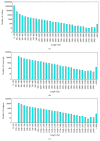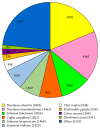De Novo Transcriptome Sequencing of the Orange-Fleshed Sweet Potato and Analysis of Differentially Expressed Genes Related to Carotenoid Biosynthesis
- PMID: 26649293
- PMCID: PMC4663004
- DOI: 10.1155/2015/843802
De Novo Transcriptome Sequencing of the Orange-Fleshed Sweet Potato and Analysis of Differentially Expressed Genes Related to Carotenoid Biosynthesis
Abstract
Sweet potato, Ipomoea batatas (L.) Lam., is an important food crop worldwide. The orange-fleshed sweet potato is considered to be an important source of beta-carotene. In this study, the transcriptome profiles of an orange-fleshed sweet potato cultivar "Weiduoli" and its mutant "HVB-3" with high carotenoid content were determined by using the high-throughput sequencing technology. A total of 13,767,387 and 9,837,090 high-quality reads were produced from Weiduoli and HVB-3, respectively. These reads were de novo assembled into 58,277 transcripts and 35,909 unigenes with an average length of 596 bp and 533 bp, respectively. In all, 874 differentially expressed genes (DEGs) were obtained between Weiduoli and HVB-3, 401 of which were upregulated and 473 were downregulated in HVB-3 compared to Weiduoli. Of the 697 DEGs annotated, 316 DEGs had GO terms and 62 DEGs were mapped onto 50 pathways. The 22 DEGs and 31 transcription factors involved in carotenoid biosynthesis were identified between Weiduoli and HVB-3. In addition, 1,725 SSR markers were detected. This study provides the genomic resources for discovering the genes involved in carotenoid biosynthesis of sweet potato and other plants.
Figures






Similar articles
-
The transcription factor IbNAC29 positively regulates the carotenoid accumulation in sweet potato.Hortic Res. 2023 Feb 1;10(3):uhad010. doi: 10.1093/hr/uhad010. eCollection 2023 Mar. Hortic Res. 2023. PMID: 36960431 Free PMC article.
-
Comparative analysis of full-length transcriptomes based on hybrid population reveals regulatory mechanisms of anthocyanin biosynthesis in sweet potato (Ipomoea batatas (L.) Lam).BMC Plant Biol. 2020 Jun 29;20(1):299. doi: 10.1186/s12870-020-02513-1. BMC Plant Biol. 2020. PMID: 32600332 Free PMC article.
-
Digital gene expression analysis based on integrated de novo transcriptome assembly of sweet potato [Ipomoea batatas (L.) Lam].PLoS One. 2012;7(4):e36234. doi: 10.1371/journal.pone.0036234. Epub 2012 Apr 27. PLoS One. 2012. PMID: 22558397 Free PMC article.
-
The potential of orange-fleshed sweet potato to prevent vitamin A deficiency in Africa.Int J Vitam Nutr Res. 2014;84(1-2):65-78. doi: 10.1024/0300-9831/a000194. Int J Vitam Nutr Res. 2014. PMID: 25835237 Review.
-
Proximate Composition, Health Benefits, and Food Applications in Bakery Products of Purple-Fleshed Sweet Potato (Ipomoea batatas L.) and Its By-Products: A Comprehensive Review.Antioxidants (Basel). 2024 Aug 6;13(8):954. doi: 10.3390/antiox13080954. Antioxidants (Basel). 2024. PMID: 39199200 Free PMC article. Review.
Cited by
-
Transcriptome analysis reveals the effects of grafting on sweetpotato scions during the full blooming stages.Genes Genomics. 2019 Aug;41(8):895-907. doi: 10.1007/s13258-019-00823-9. Epub 2019 Apr 27. Genes Genomics. 2019. PMID: 31030407
-
A Sweetpotato Auxin Response Factor Gene (IbARF5) Is Involved in Carotenoid Biosynthesis and Salt and Drought Tolerance in Transgenic Arabidopsis.Front Plant Sci. 2018 Sep 11;9:1307. doi: 10.3389/fpls.2018.01307. eCollection 2018. Front Plant Sci. 2018. PMID: 30254657 Free PMC article.
-
Improvement for agronomically important traits by gene engineering in sweetpotato.Breed Sci. 2017 Jan;67(1):15-26. doi: 10.1270/jsbbs.16126. Epub 2017 Feb 24. Breed Sci. 2017. PMID: 28465664 Free PMC article. Review.
-
A genome-wide BAC-end sequence survey provides first insights into sweetpotato (Ipomoea batatas (L.) Lam.) genome composition.BMC Genomics. 2016 Nov 21;17(1):945. doi: 10.1186/s12864-016-3302-1. BMC Genomics. 2016. PMID: 27871234 Free PMC article.
-
A comprehensive overview of omics-based approaches to enhance biotic and abiotic stress tolerance in sweet potato.Hortic Res. 2024 Jan 12;11(3):uhae014. doi: 10.1093/hr/uhae014. eCollection 2024 Mar. Hortic Res. 2024. PMID: 38464477 Free PMC article.
References
-
- Padmaja G. Uses and nutritional data of sweetpotato. The Sweetpotato. 2009:189–234. doi: 10.1007/978-1-4020-9475-0_11. - DOI
-
- Oki T., Masuda M., Furuta S., Nishida Y., Terahara N., Suda I. Involvement of anthocyanins and other phenolic compounds in radical-scavenging activity of purple-fleshed sweet potato cultivars. Journal of Food Science. 2002;67(5):1752–1756. doi: 10.1111/j.1365-2621.2002.tb08718.x. - DOI
-
- Zang N., Zhai H., Gao S., Chen W., He S. Z., Liu Q. Efficient production of transgenic plants using the bar gene for herbicide resistance in sweetpotato. Scientia Horticulturae. 2009;122(4):649–653. doi: 10.1016/j.scienta.2009.06.023. - DOI
-
- Manifesto M. M., Costa Tártara S. M., Arizio C. M., Alvarez M. A., Hompanera N. R. Analysis of the morphological attributes of a sweetpotato collection. Annals of Applied Biology. 2010;157(2):273–281. doi: 10.1111/j.1744-7348.2010.00425.x. - DOI
LinkOut - more resources
Full Text Sources
Other Literature Sources

